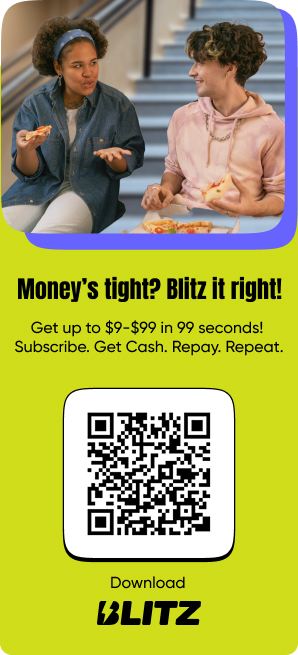Picture this: you are in college and managing late-night study sessions, part-time jobs, and a heap of bills. Just when you think your account can’t take it anymore, credit card debt and student loans come along to make a perfect storm.
The real challenge isn’t just paying both; it’s figuring out which one to tackle first. Credit cards can drain you fast with high interest, while student loans stretch out for years. Most students don’t realize that choosing the right payment strategy can save thousands and reduce stress.
That’s where Blitz comes in. Its BudgetGPT helps you map out which debt deserves attention first, while tools like Instant Cash keep you from missing payments when money gets tight. Ready to learn about balancing credit card & student loan payments? Keep reading!
Understanding the Basics of Credit Card & Student Loan Debt
Money stress can hit hard when you’re dealing with both credit card balances and student loans. But the tricky part is they don’t work the same way, and that’s exactly why understanding the basics makes a huge difference.
What Makes Credit Card Debt So Expensive?
Credit cards start out feeling convenient, but they get expensive quickly. Even if you’re paying each month, the interest keeps building and makes it harder to cut down the balance. Because:
- Interest rates are insanely high (usually 20%+).
- Interest compounds daily, meaning the balance grows faster if you don’t knock it down.
- Minimum payments trick you into thinking you’re fine—but really, you’re just feeding the bank.
In short, if you only pay the minimum, you’ll be stuck forever and pay double (sometimes triple) the original balance.
Student Loan Debt – What You Need to Know
Student loans are different. Often, the interest rates are lower, especially for federal loans, and you may have flexible repayment options:
- Fixed or income-driven payments
- Loan forgiveness programs for qualifying federal loans
Student loans usually hang around for years. Unlike credit cards, the payoff isn’t quick—but mismanaging them can still sabotage your finances.
The Priority Framework: How to Balance Credit Card & Student Loan Payments
Juggling two debts can be daunting. But breaking it down into a process simplifies it. The priority framework enables you to understand where to begin and how to keep moving forward. Here’s how you can juggle:
Step 1: List All Your Debts and Interest Rates
Before you can beat debt, you need to see it clearly. Many students underestimate how much they owe because it’s scattered across cards and loans. Writing it all down is the first big step.
Here’s how to start:
- Write out every credit card balance and each student loan.
- Add the interest rate for each, because the higher it is, the faster the money disappears.
- Don’t forget the minimum payments, so you know your baseline.
Step 2: Focus on High-Interest Debt First
Now that you’ve got clarity, it’s time to go after the debt that’s quietly costing you the most. This is usually your credit cards, their high interest rates grow fast if left alone. Here’s the strategy:
- Identify which balance has the highest interest rate.
- Pay minimum payments on everything except the highest-interest debt and allocate extra funds to that one.
- Run payment simulations in BudgetGPT to see how much faster you’ll wipe out debt with this strategy.
Even a small extra payment on high-interest debt can add up. Read here about Emergency Loans for Students.
Step 3: Consider Your Financial Situation & Goals
Debt goes beyond numbers; it impacts your life and choices. Your plan should be about your reality, not math.
Ask yourself:
- Are you eligible for income-driven repayment or student loan forgiveness? In the event that you are, then the credit card debt should be your main concern.
- In case you are not, keep paying student loans regularly to avoid a snowball of long-term interest.
Blitz can do the calculation based on your income, debt, and goals. It is the long-term implications of the various strategies that help you make a well-informed, wise decision.
Step 4: Create a Payment Schedule You Can Stick To
A plan without doing anything is a dream. Once you know your payment amounts and dates, set up a schedule that you can follow.
Here’s how:
- Set a monthly schedule: Choose the amount for credit cards and student loans.
- Automate payments: Use reminders or auto-pay to meet deadlines easily.
- Track progress: Stay motivated and be on your way to achieving your goal while watching your balances get reduced over time.
With Blitz’s BudgetGPT, your schedule adjusts automatically if your income changes. This keeps payments realistic and effective.
How Blitz Can Help You Manage Credit Card & Student Loan Debt
Managing credit cards and student loans is tough. One month you’re on top of things, the next you’re wondering how you’ll make all the payments. It’s like having a personal finance buddy who keeps you on track, shows you what to tackle first, and helps prevent those “oops” moments with late fees.
Blitz’s BudgetGPT for Prioritizing Payments
BudgetGPT eliminates budgeting anxiety by placing your money where it is needed most. It tackles high-interest debt first. If your income changes, it adjusts automatically. This keeps you on track with student loans and credit cards.
Example: When your paycheck decreases after a summer gig ends, Blitz adjusts your budget instantly so you continue on course.
Blitz’s Debt Tracker & Loan Management Tools
Blitz’s Debt Tracker keeps all your balances in one place so you always know where you stand. From credit cards to student loans, you’ll see progress clearly and get reminders that make late payments a thing of the past.
Blitz’s Instant Cash for Emergency Support
Instant Cash covers you when life throws surprises. If payday is late but bills are due now, Blitz helps fill the gap so you avoid late fees, missed payments, and unnecessary stress on your credit score.
Case Studies: How to Apply the Priority Framework
Reading about strategies is helpful, but seeing how they play out in real life hits differently. These examples show how students and grads can apply the priority framework to tackle debt while using Blitz to stay on track.
Case Study 1: Graduate with $20k Student Loan Debt and $5k Credit Card Balance
Meet Alex, A recent grad working their first job brings home about $2,200 monthly. With $5k in credit card debt at 22% and $20k in student loans at 5%, they focus on tackling the card first.
In just under two years, it’s gone, saving thousands of dollars. Blitz tracks progress, so shifting payments to loans feels seamless.
Case Study 2: $30k Student Loan Debt and $10k Credit Card Balance
Now, let’s meet Jamie, another grad juggling $10k in credit card debt at 24% and $30k in loans at 6%. Following the priority framework, they attack the card balance hard while covering loan minimums.
In the next three years, the credit card will be paid off, thus Blitz will be recalculating budgets automatically, making the repayment of the student loan less stressful.
Tips for Staying on Track with Credit Card & Student Loan Payments
It is as important to stick to your debt plan as it is to start one. Here are some tips:
Build an Emergency Fund to Avoid Accruing More Debt
Having a small emergency fund stops you from swiping your credit card for surprise expenses. Blitz’s BudgetGPT helps you balance savings with debt payments so emergencies don’t become new debt.
Refinance or Consolidate Your Student Loans If Possible
Refinancing will help to reduce your interest rates, whereas consolidation will make it easier to manage the multiple loans you have. Blitz’s refinancing tools compare options instantly, showing if it’s smart for you without risking forgiveness benefits or long-term stability.
Avoid Using Credit Cards for Non-Essential Purchases
Cutting back on credit card use is key for paying off debts. Blitz’s BudgetGPT sets clear spending limits so you focus on essentials, dodge overspending, and keep progress moving on debt repayment.
FAQs on Balancing Credit Card & Student Loan Payments
Should I prioritize paying off credit card debt or student loans first?
Most of the time, credit cards come first—they cost way more in interest. Pay those down while keeping minimum payments on student loans. Once the cards are clear, shift your focus toward student loans.
Can I use Blitz’s tools to help me prioritize my debt payments?
Yes, Blitz was built for this. BudgetGPT shows you a clear payment plan, while the Debt Tracker lists all balances in one place. It’s like having a personal money coach.
What is the debt avalanche method, and how can it help me pay off debt faster?
The debt avalanche strategy focuses on paying the highest-interest debt first. This reduces interest expenses and hastens payment. It saves thousands compared to paying randomly, and Blitz runs the numbers instantly.
How do I know if refinancing my student loans is the right option for me?
If the new interest rate is lower and you don’t need federal benefits, refinancing could save you thousands. Blitz compares scenarios for you so you know if it’s a smart move.
Can Blitz’s Instant Cash help me make credit card payments on time?
Absolutely. Instant Cash is there for short-term gaps, so you never miss due dates. It covers you when paychecks are delayed and helps protect your credit score from late fees or penalties.
Conclusion – Managing Both Debts Effectively
Balancing credit card debt and student loans can feel overwhelming. But with the right framework, you can pay credit card debt first, unless forgiveness makes student loans a special case for you.
With Blitz backing you, you don’t have to figure it all out alone. From BudgetGPT helping you map out monthly cash flow, to Debt Tracker keeping your balances organized, to Instant Cash covering those last-minute emergencies—Blitz makes debt management doable.
So the next time your credit card bill and loan payment hit the same week, you won’t panic. You’ll open Blitz, follow the priority framework, and start paying your way to freedom way faster than you think.





